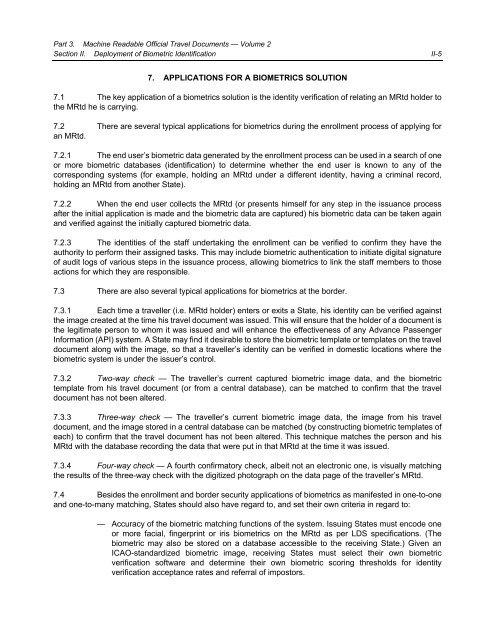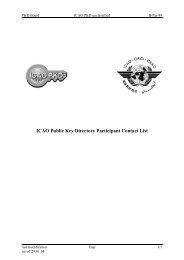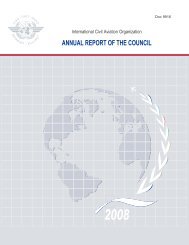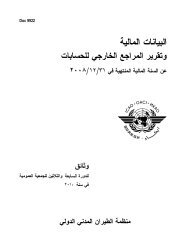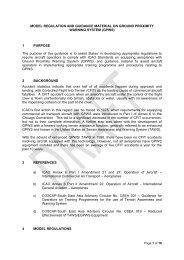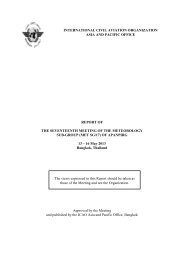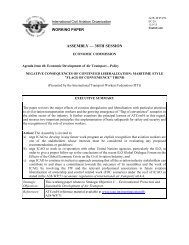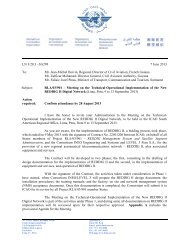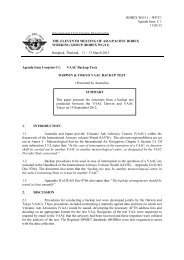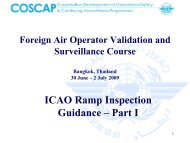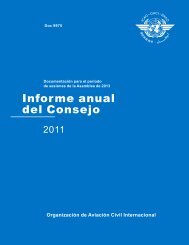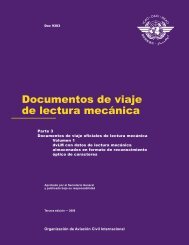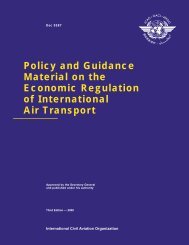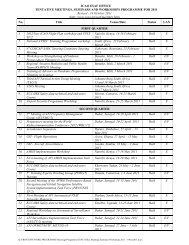Machine Readable Travel Documents - ICAO
Machine Readable Travel Documents - ICAO
Machine Readable Travel Documents - ICAO
Create successful ePaper yourself
Turn your PDF publications into a flip-book with our unique Google optimized e-Paper software.
Part 3. <strong>Machine</strong> <strong>Readable</strong> Official <strong>Travel</strong> <strong>Documents</strong> — Volume 2<br />
Section II. Deployment of Biometric Identification II-5<br />
7. APPLICATIONS FOR A BIOMETRICS SOLUTION<br />
7.1 The key application of a biometrics solution is the identity verification of relating an MRtd holder to<br />
the MRtd he is carrying.<br />
7.2 There are several typical applications for biometrics during the enrollment process of applying for<br />
an MRtd.<br />
7.2.1 The end user’s biometric data generated by the enrollment process can be used in a search of one<br />
or more biometric databases (identification) to determine whether the end user is known to any of the<br />
corresponding systems (for example, holding an MRtd under a different identity, having a criminal record,<br />
holding an MRtd from another State).<br />
7.2.2 When the end user collects the MRtd (or presents himself for any step in the issuance process<br />
after the initial application is made and the biometric data are captured) his biometric data can be taken again<br />
and verified against the initially captured biometric data.<br />
7.2.3 The identities of the staff undertaking the enrollment can be verified to confirm they have the<br />
authority to perform their assigned tasks. This may include biometric authentication to initiate digital signature<br />
of audit logs of various steps in the issuance process, allowing biometrics to link the staff members to those<br />
actions for which they are responsible.<br />
7.3 There are also several typical applications for biometrics at the border.<br />
7.3.1 Each time a traveller (i.e. MRtd holder) enters or exits a State, his identity can be verified against<br />
the image created at the time his travel document was issued. This will ensure that the holder of a document is<br />
the legitimate person to whom it was issued and will enhance the effectiveness of any Advance Passenger<br />
Information (API) system. A State may find it desirable to store the biometric template or templates on the travel<br />
document along with the image, so that a traveller’s identity can be verified in domestic locations where the<br />
biometric system is under the issuer’s control.<br />
7.3.2 Two-way check — The traveller’s current captured biometric image data, and the biometric<br />
template from his travel document (or from a central database), can be matched to confirm that the travel<br />
document has not been altered.<br />
7.3.3 Three-way check — The traveller’s current biometric image data, the image from his travel<br />
document, and the image stored in a central database can be matched (by constructing biometric templates of<br />
each) to confirm that the travel document has not been altered. This technique matches the person and his<br />
MRtd with the database recording the data that were put in that MRtd at the time it was issued.<br />
7.3.4 Four-way check — A fourth confirmatory check, albeit not an electronic one, is visually matching<br />
the results of the three-way check with the digitized photograph on the data page of the traveller’s MRtd.<br />
7.4 Besides the enrollment and border security applications of biometrics as manifested in one-to-one<br />
and one-to-many matching, States should also have regard to, and set their own criteria in regard to:<br />
— Accuracy of the biometric matching functions of the system. Issuing States must encode one<br />
or more facial, fingerprint or iris biometrics on the MRtd as per LDS specifications. (The<br />
biometric may also be stored on a database accessible to the receiving State.) Given an<br />
<strong>ICAO</strong>-standardized biometric image, receiving States must select their own biometric<br />
verification software and determine their own biometric scoring thresholds for identity<br />
verification acceptance rates and referral of impostors.


